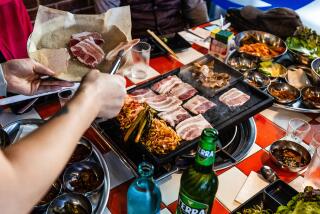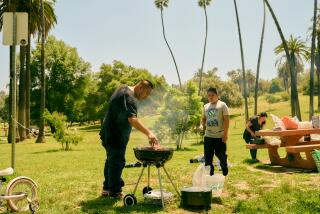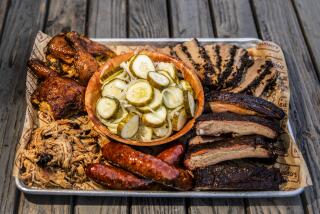On the Grill
- Share via
Grilling as we know it goes back to Henry Ford.
In the beginning, which was the early ‘30s, there was already a thing called the camping grill: a gizmo made of sheet metal you could carry to your campsite and unfold when you were ready to cook.
It happened that charcoal briquettes had just been invented by the Ford Motor Co. as a way to use up hardwood left over from building folding tops for its Model Ts and Model As. Ford originally saw them as an industrial fuel, but he also shrewdly contracted with a company in Eden, New York, to build camping grills stamped with the Ford name. You got an introductory sack or two of briquettes with your grill.
The next stage didn’t come until after World War II, when the suburban back yard came into its own, above all in Southern California. It was here in patio-land that the larger, heavier outdoor style barbecue originated, at first often made out of a war surplus oil drum.
In 1951 the Big Boy Co. of Burbank invented the wheeled wagon-style grill. Sears, Roebuck stocked it, and the back yard barbecue phenomenon spread around the country. Soon models with shelves, hoods and all--not far from styles we have today--were available. Gas and electric grill models were introduced in the late 50s.
Grill styles may not have changed much since then, but the wide selection of brands and sizes is mind-boggling. Budget and need, frequency of use will likely affect your decision. Inexpensive, portable grills have limited capacity and function but they’re useful for picnics, boats and tailgating. Larger more elaborate grills with all the bells and whistles are a bigger decision.
In shopping for any type of grill, look for safety features such as tip-proof bases or carts, strong leg posts and stay-cool handles. Shake up those grill wagons in the stores--you’ll be surprised how wobbly some of them are. A higher-domed hood is helpful for taller food items. When closed, the hood should hardly touch the grate area so precious grilling space isn’t lost.
Grates should be sturdy and adjustable for better heat control. The ideal grate finish is cast iron because of energy-saving heat retention. It also puts those distinctive restaurant-style grill marks on the food. The drawback is that cast iron requires care before and after use to guard against rusting.
Newer equipment models offer some of these innovative features: Bottom ash catchers for neat clean-up. Porcelainized cast iron grids to alleviate rusting. Range-style side burners for outdoor sauce heating, or for outdoor frying so that odors don’t linger indoors. Heavy duty rotisseries for turkey roasting. The ability to smoke food as well as to cook it. Built-in trays for smoke chips so they don’t clog up gas lines. Warming bread trays or baskets.
For crowd party givers, there are monster-size barbecue grills, such as Weber’s huge Ranch Kettle. You could fit about 20 Cornish hens and about ten potatoes in its 1,104 inches of cooking space.
Today charcoal and gas are still the favorite ways of grilling. Charcoal loyalists unconvinced about the flavor quality derived from gas or electric grilling might check out two upscale charcoal grills: the brand new Kingsford Pro Charcoal Grill from Clorox Co. and the high-tech styled Char-Broil from W.C. Bradley Enterprises, Inc. Both units offer features that the average charcoal grill lack.
Grills fueled by gas (either propane or natural) are neat and convenient, and handy for those who don’t have time to build fires. If price is no object, you might be interested in these two upscale models. From the land of “barbie” parties comes the Turbo Australian Gas Grill with lava rock, imported by Stuart McDonald of Barbeques Galore from Down Under.
Then there’s the Weber Genesis Series with flavorizer bars. Weber keeps adding to the series and every year, they come up with a new accessory. Top of the line is Genesis 5. A variation of the Genesis is the Perma-Mount Gas Barbecue, a stationary gas grill that replaces old grills attached to a natural gas source.
The camping grill lives on. The Weber Smokey Joe Tuck-N-Carry charcoal grill and the indoor/outdoor Iwatani Cassette Feu Gas Hibachi, which uses small butane cylinders, are both portable. And don’t forget that the hibachi is wonderful for cooking at the table; it’s like being in a Korean barbecue restaurant. Our testings found that all of these grills performed to our satisfaction. Here’s a summary of their features. Judge for yourself.
BARBECUE GRILLS
Kingsford Pro Charcoal Grill $199
A black kettle grill on a metal rolling cart, with bottom rack and redwood shelves on either end. Cooking area: 400 square inches.
Advantages: Oval cooking area. High-domed hood accommodates large pieces of meat. Top and bottom air vents. Easy-cleaning porcelainized grate. Middle section of grid is hinged, opens separately for access to coals. Ash catcher under grill.
Disadvantages: Height of grate is not adjustable; food can only be cooked six inches above the coals.
Available at Gelson’s, specialty grill stores, hardware stores. Or call toll-free 800-537-2823. Char-Broil Charcoal Grill $300
A charcoal grill with sable black cast aluminum grill body, hardwood shelves, vinyl-coated wire bottom shelf. Four separate grates. Cooking area: 581 square inches.
Advantages: Cooking grate adjusts to four heights. Large front door for charcoal loading. Hood thermometer. Large ash drawer.
Disadvantages: Cast iron grates require care to prevent rusting (generously rub with oil and place in 350-degree oven 2 to 3 hours). Bottom ash drawer is cumbersome and hard to clean.
Available at specialty grill stores, hardware stores. Turbo Australian Gas Grill from $699 to $789
An enamel-covered black porcelain gas grill in a double-deck Jarrah wood; can be built in. Cooking area: 500 to 725 square inches depending on number of burners (three, four or five; 60,000 to 100,000 BTUs).
Advantages: Can use only one burner for small jobs. Hood thermometer. Add-on accessories include wok plate, rotisserie, bar sink, griddle plates in place of grates, even a refrigerator.
Disadvantages: High price. Cast iron cooking grates require storage care and periodic seasoning (porcelainized grates available: $50 extra). Lava rocks tend to collect grease.
Available at Barbeques Galore.
Weber Genesis 5 Gas Grill $899
A gas barbeque equipped with 8,000 BTU range burner as well (separate ignitor and control). Available with grey or burgundy porcelain metal hood with pin stripes. Grey-stained wood shelves, tempered glass-enclosed bottom storage area. Cooking area: 420 square inches, 36,000 BTUs.
Advantages: Porcelain enamel smoker to hold wood chips and water. Removable 213-square-inch warming basket. Dual purpose thermometer: reads doneness of food as well as temperature of cooking chamber. Funnel-shaped bottom tray to draw grease away from burners. Patented heat-conducting angled bars below cooking grate to eliminate grase flare-ups. Safety stystem shuts off gas when flames go out. Spider stopper guard to keep gas lines clear. Gas gauge measures gas in tank by hanging weight rather than pressure.
Disadvantages: Lower BTUs require slightly longer preheating stage to obtain high heat for searing. Bottom bars require individual clean-up.
Available at specialty grill stores, hardware stores and select lawn and garden outlets. Or call (800) 323-7598. Less elaborate, smaller Genesis models with lower pricing are also available.
Weber Genesis Perma-Mount Gas Grill $899
Identical to Genesis 5 but can be permanently affixed to patio or deck with natural gas outlets.
Weber Smokey Joe Tuck-N-Carry $39
A portable black kettle grill with removable bowl and lid, zinc-plated legs. Cooking area: 150 square inches.
Advantages: Reasonable price for sturdy portable. Space saving (14 1/2-inches in diameter, 16 1/2 inches tall). Lid lock holds the top on during carrying and lowers to serve as lid holder, helps protect against wind.
Disadvantages: Limited (150 square inch) cooking capacity. Non-adjustable grid.
Available at Gelson’s, hardware and grill shops.
Iwatani Cassette Feu Gas Hibachi Model G-6 $146
Lightweight rectangular black and grey metal grill. Operates solely with Iwatani butane canister (using 1 canister per 1 1/2 hours). Flame runs around edges of steel burner, heat adjusted by switch control; 7,619 BTUs per hour.
Advantages: Easy to operate, easy to clean. Automatic electric ignition. Suitable for indoor tabletop cooking as well as outdoor toting.
Disadvantages: Limited space capacity. Not good for larger poultry pieces. Drip tray catches grease spills but must be refilled periodically. Butane canisters (about $3.50 per can) can run up costs if cooking for long periods.
Available at Japanese markets, hardware stores. Or call 324-9174 for store near you.
More to Read
Sign up for The Wild
We’ll help you find the best places to hike, bike and run, as well as the perfect silent spots for meditation and yoga.
You may occasionally receive promotional content from the Los Angeles Times.






